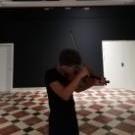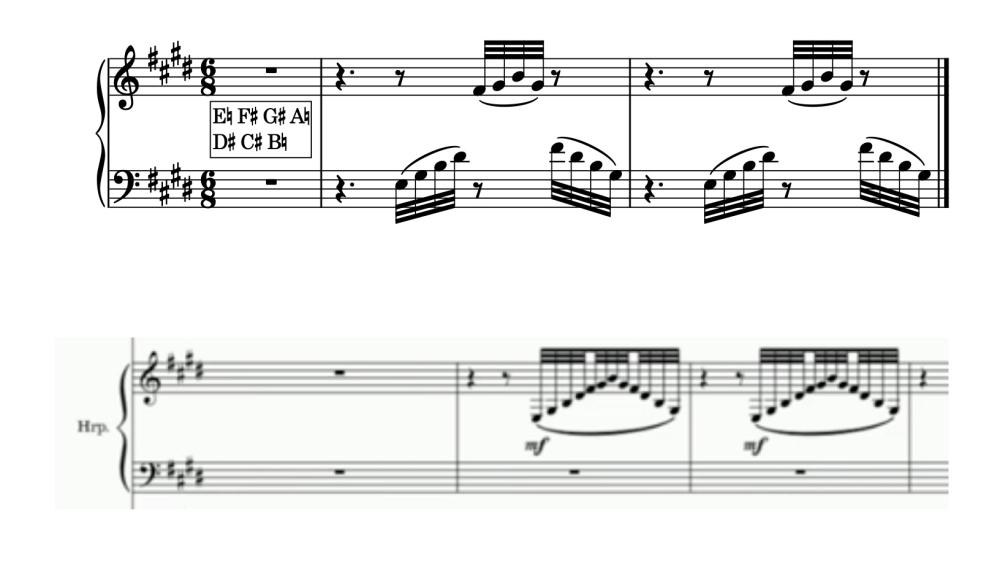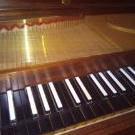Leaderboard
Popular Content
Showing content with the highest reputation on 01/06/2023 in all areas
-
Hello guys. I am working in this group of two musical poems. Listening to a lot of Scriabin and Rachmaninoff is helping me to discover a new world. I must warn I am very busy right now with my interpretation classes and I barely have time to compose, so the second one will take more time.1 point
-
Moderate difficulty and modest ranges for all vocal parts. There are a few notes of divisi for every part but the tenors. I'd love to hear what you think, and pianists, let me know if the piano reduction would be better with any notes moved to the other hand. (I'm not a pianist). Thanks for your thoughts! The text follows the lifecycle of the bumble bee. Unlike domesticated honey bees, out of the whole colony, only new bumble bee queens survive the winter each year. Each new pregnant queen must carefully select a nest site after emerging for winter dormancy and start a colony all alone. For the first few weeks of spring, she must divide her time between laying eggs, gathering and preparing nectar and pollen, and warming and caring for her new offspring. If her nest site proves to be too far from a continual succession of blooms while the weather is still cool, her babies will succumb to the cold while she is away from the nest gathering food for them. Until the first generation of workers are old enough to take over some of the tasks of caring for the group, allowing for grocery trips further from home, and warm temperatures and the flood of summer flowers makes comfort and food supplies more sure, her nest's survival is tenuous. But if all goes well, by the time summer wanes, hundreds of her children will be busy among the blooms, and her own new queens will be preparing to disperse and carry on the cycle the next year. It's also important to remember that although we may see hundreds of bumble bees out in the garden, genetically speaking, each nest counts as one individual. One reproducing queen: one set of genes being passed down. All those workers don't generally count. So when you are thinking about the survival of a bumble bee species, you need not just lots of bumble bees, but lots of bumble bee nests in an area in order to have the genetic diversity that allows the population to continue in a healthy way. Too few nests, each headed by a single reproducing queen, and even though you see tons of bees on the landscape, they may be in danger of slow local extinction from inbreeding. You can help! A mowed lawn, a sea of mulched flower bed, or a paved parking area is not bee habitat. None of these provide nesting sites or food. Bumble bees need drifts of fallen leaves to hide their nests under in summer, and for the queens to pass the winter under. So don't rake at least part of your yard, or compost your leaves in a big pile on site. Thick clumps of long grasses are also popular nesting sites. If you could hide a rabbit in it, it's probably thick and clumpy enough. Cohabitating with chipmunks in their holes is also popular, so tolerate those cute little guys in your yard. And be sure to have plenty of native flowering plants in your yard. Our local bees evolved with our local plants. Often plants from other continents don't have the right flower shape for them to access, bloom at the wrong time, or don't provide the right nutrition they need to thrive. Humans mess around with breeding flowers for color and size so much, that often we end up breeding flowers that actually contain no nectar or pollen. Oops! No food there at all!1 point
-
Hi all. This was my first attempt at using loops in GarageBand. The sax is made from standard Apple loops, and the percussion is automated: so the only thing that's actually me is the piano! Feels like cheating really. Not sure it's a good way to make music.1 point
-
That's a good point, and something I do generally try to do. Not sure why I didn't really get there on this one! Thanks for the thought! And, hurrah for your future bee paradise! 🙂1 point
-
1 point
-
Yeah it's not plucked like a harpsichord. The action is very simple, with each key acting as a lever with a "tangent" or a blade attached to it, which touches the string when the key is depressed. Harpsichord is a little more complicated but not much, and pianos are quite a bit more complex. The sound is very quiet so it's good for playing late at night and if you live in an apartment. Unlike a harpsichord, it does have the ability to use dynamics. Thanks for listening Luis1 point
-
Very nice music. It flows and has many colors and textures. the brass section is missed, it would bring some shiny parts. the long slurs make no sense in the strings, I prefer writing legato…. in the first part the harp could be notated better.1 point
-
I like your language, it's tonal but modal/spicy. I really like the chord at bar 15, very cool! One thing is I would have liked to have heard more individual voices, or parts where there's only two singing. A more sparse texture in spots could have really given this a more dynamic feel, but then again I complain about that all the time. In general I think it's always good for music. Piano reduction looks fine and logical to me. Great stuff here, thanks for sharing! If I ever have my own yard, my own little piece of ground, you'll be happy to know I'd make it bee heaven1 point
-
Hello Henry. First of all thank you very much for your words. As you say, I've been composing something lately and what has motivated me to work have been the works of Scriabin, I'm discovering beautiful music, but I'm a bit stuck due to the formal structure of the work, I guess with a little effort will be done soon. One of the weak points I have is that, although I really like to compose small works like this, I can't manage to make large movements of long duration. If I still having doubts on the work, maybe I will post here the incompleted work. Greetings ^^1 point
-
Wow it is so enjoyable! I love that saxophone even it's a cheating sound!😅 It would be better if there's a solo jazz on piano I guess? But this is so soothing to listen to. Thanks for sharing! Henry1 point
-
Excellent, in a Chopin-like style! I would suggest to use it as part of a larger composition. It sound a bit like a fragment to me. (but good!)1 point
-
Thank you I am really pleased that you like it! Thanks a lot for your valuable inputs ! I agree with you that this piece is perhaps the best of the three movements. I put a lot of work in it to obtain coherence and consistency. The passage of ms 83-84 was something I added on later. Originally, I went from 82 to 85 (which works OK as well) but I wanted to break up the rhythm ( and avoid monotony) a bit. But maybe it is somewhat abrupt. I will think about it. Thank you for pointing out the spelling issues. I agree that ms 205 should be spelled with flats, and I will change this. But I am a bit confused about your suggestion for ms 138. I think that this measue is still part of an E minor key (which changes to E major in ms 119). I woul fully agree with your spelling if it would be part of the E-major key. Could you explain this issue to me? The feeling about "not enough finality" is in fact similar to what I felt before, but I did not do anything about it. Thank you for reminding me! There are two ways to deal with this: 1) I coud re-write and extend the ending of the piece or 2) write another movement. I think that the last option is the best. I am already thinking of a scherzo as the finale of the sonata, but I will do it later. I am too much occupied with two new pieces. Best regards, and thank you for a great recview! Hello Louis, Thank you for your comments. I can tell you that it is not easy for me as well. It is not something I can do in a day or two!1 point
-
Oh now I get it! The abrupt chords espress what you want to espress! I do feel creepy with those strange chords. Great job here! I would have probably end with a low E though, but if that's your favourite one, then this will be good! Thank you for your clarification! Henry1 point
-
Thanks so much for taking the time to give it a thorough listen, Henry. I really appreciate your comments. Yes, I did want an abrupt transition at bar 15, as we go from a pretty, wistful discussion of flowers: "ah... the flowers are gone so quickly, such a shame..." to the main theme of the text: "the survival of the bees in early spring is precarious... how terrifying to be a mother bee in spring..." I wanted a sharp turn in the music there to a feeling of anxiety, that then steadily builds. Measure 32 and 34, I wanted to feel a bit creepy. The vegetation is growing so fast and thick and strange at certain times during the summer that it is a little unsettling how quickly it shoots up. Think Audrey 2 from Little Shop of Horrors. Is it wonderful, or is it worrying how fast the vines twine around the porch railings and scale the trees? The second inversion at the end was mainly about the bass part. I wanted the basses to have a chance to proceed down the staff and majestically unfurl their low range, for a feeling of contentedly sinking into a warm bath. I tried the ending a few different ways, but this was the one I liked best. Thank you for your thoughts, and I'm glad to hear my piano reduction looks okay!1 point
-
Thanks Henry, really appreciate it.......there is a score for all the movements but the second branle/ brawl, which I have yet to write down. However, it looks like I didn't scan the gigue for some reason, although the score exists. Finally, there are wrong notes in my scanned copy of the score, as well as some beats that are entirely missing in certain places, so it's something that absolutely needs to be edited. But in any case, here are the three movements that i scanned last summer1 point
-
Hi @pateceramics, The opening is refreshing. I love the middle section. They are in unison and really depicts how busy and homogenous the working bees are. I just find the bridge to it a little bit abrupt with the means of an F major chord though. I notice there are quite a number of parallels throughout the song. Is that your intended sound? I find it quite fine to have these parallels, since it adds the earthly feeling. B.32 and 34 seems quite weird for me with a D-A# augmented fifth resolved, then move to a perfect fifth of E-B. I find the sound really in clash with each other. And to end on a second inversion chord. What is the implication of that? Is that to minimize the stability of the ending? For the piano part I find it absolutely fine in terms of playing it. No problem on that. Thanks for sharing! Henry1 point
-
Please let me know if this works for you. Basically, reset your password on the "sign in" page. Or I could reset your password for you too.1 point
-
This was my entry for the National Young Composers Challenge. I did not end up winning, but the judges enjoyed it, particularly the introduction. I will definitely be participating again for next year. This was also my first test of the new MuseSounds, and I am very excited about it. I was quite impressed with the realism of it, though I don't really like the trumpet all that much, as the dynamics are inconsistent. Feedback is definitely appreciated, especially since I am planning on expanding the material into a full symphony.1 point
-
This is indeed true. I assumed it would do that automatically and didn’t even bother to check. I originally had it with the horns but I thought that it would overpower the strings to much. Maybe it wouldn’t, but that was my thought. That sounds right. I might just simplify the rhythm for the bass trombone the whole way through that section. OK. I’ll try different mixings of the strings there and see what works best. Maybe violins I with cellos and violins II with violas. We’ll see What I do: I’ll definitely try this out. Looks like it would work quite well, thanks. 😊1 point
-
Hi, just find this nice little piece! I love it since it is idiomatic to the piano. And the harmony is good as well! It's a few months now so maybe you have some new compositions done I guess?🤔You can post them here too! Henry1 point







